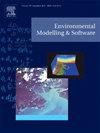Navigating the space between empirics and theory – Empirically stylized modelling for theorising social-ecological phenomena
IF 4.8
2区 环境科学与生态学
Q1 COMPUTER SCIENCE, INTERDISCIPLINARY APPLICATIONS
引用次数: 0
Abstract
The potential of agent-based modelling (ABM) for developing theory has been recognized, yet methodologies are lacking. Building theories of social-ecological systems is challenging because of complex causality, context-dependence, and social-ecological interdependencies. We propose an approach that addresses these challenges through combining case-based empirical research with ABM in a collaborative modelling process. In-depth empirical research is essential for identifying a puzzle and potential explanations thereof, and for recognizing context and social-ecological interdependencies. Collaborative model building and analysis enables careful abstraction and reflection, and allows further exploring and testing the emerging theory in dynamic contexts, leading to better-grounded and transparent assumptions and theories. We call this approach BIM (Being In the Middle) and articulate it through three features: contextually embedded, collaboratively abductive and empirically stylized. We highlight how BIM facilitates new interdisciplinary avenues for discovering social-ecological interdependencies, discuss how it can be applied and what challenges and frontiers lie ahead.
导航经验和理论之间的空间-经验风格化建模的理论社会生态现象
基于主体的建模(ABM)在发展理论方面的潜力已被认识到,但缺乏方法。由于复杂的因果关系、背景依赖性和社会-生态相互依赖性,构建社会-生态系统理论具有挑战性。我们提出了一种方法,通过在协作建模过程中结合基于案例的实证研究和ABM来解决这些挑战。深入的实证研究对于确定一个谜题及其可能的解释,以及认识背景和社会生态的相互依存关系至关重要。协作模型的构建和分析使仔细的抽象和反思成为可能,并允许在动态环境中进一步探索和测试新出现的理论,从而产生更好的基础和透明的假设和理论。我们称这种方法为BIM(处于中间),并通过三个特征来表达它:上下文嵌入,协作溯因和经验风格化。我们将重点介绍BIM如何促进新的跨学科途径,以发现社会生态的相互依赖性,讨论如何应用它以及未来的挑战和前沿。
本文章由计算机程序翻译,如有差异,请以英文原文为准。
求助全文
约1分钟内获得全文
求助全文
来源期刊

Environmental Modelling & Software
工程技术-工程:环境
CiteScore
9.30
自引率
8.20%
发文量
241
审稿时长
60 days
期刊介绍:
Environmental Modelling & Software publishes contributions, in the form of research articles, reviews and short communications, on recent advances in environmental modelling and/or software. The aim is to improve our capacity to represent, understand, predict or manage the behaviour of environmental systems at all practical scales, and to communicate those improvements to a wide scientific and professional audience.
 求助内容:
求助内容: 应助结果提醒方式:
应助结果提醒方式:


